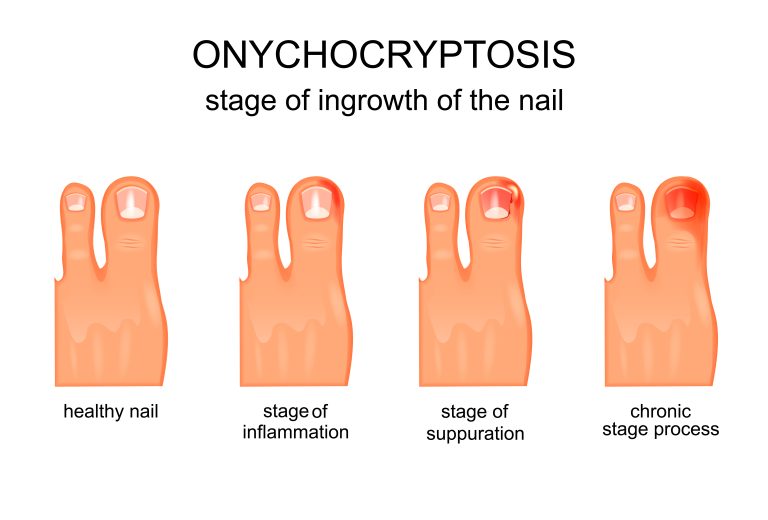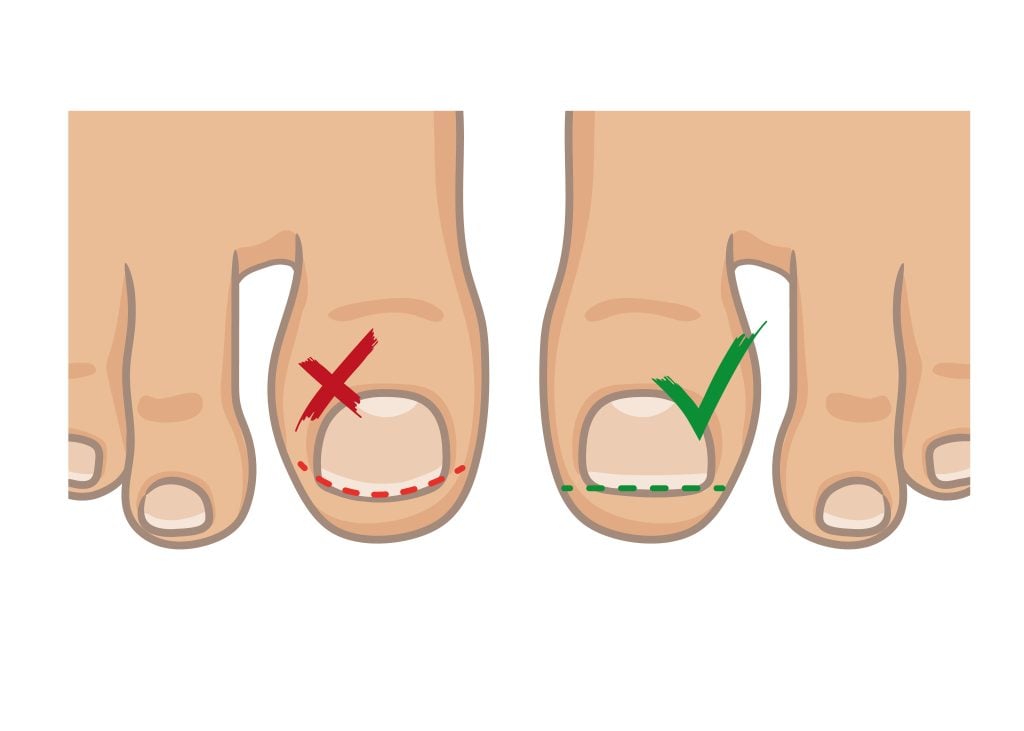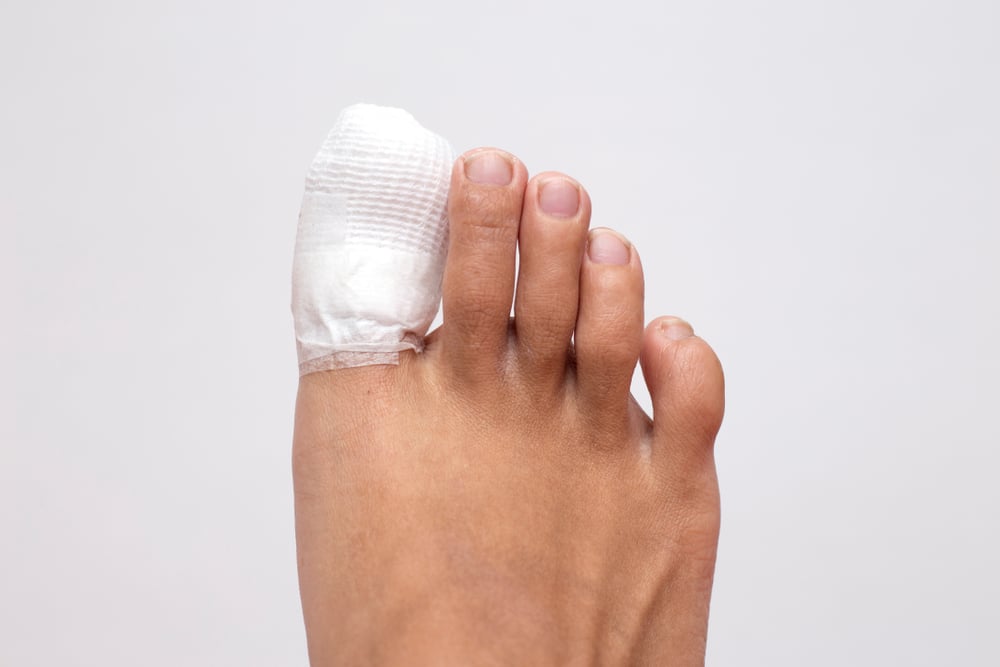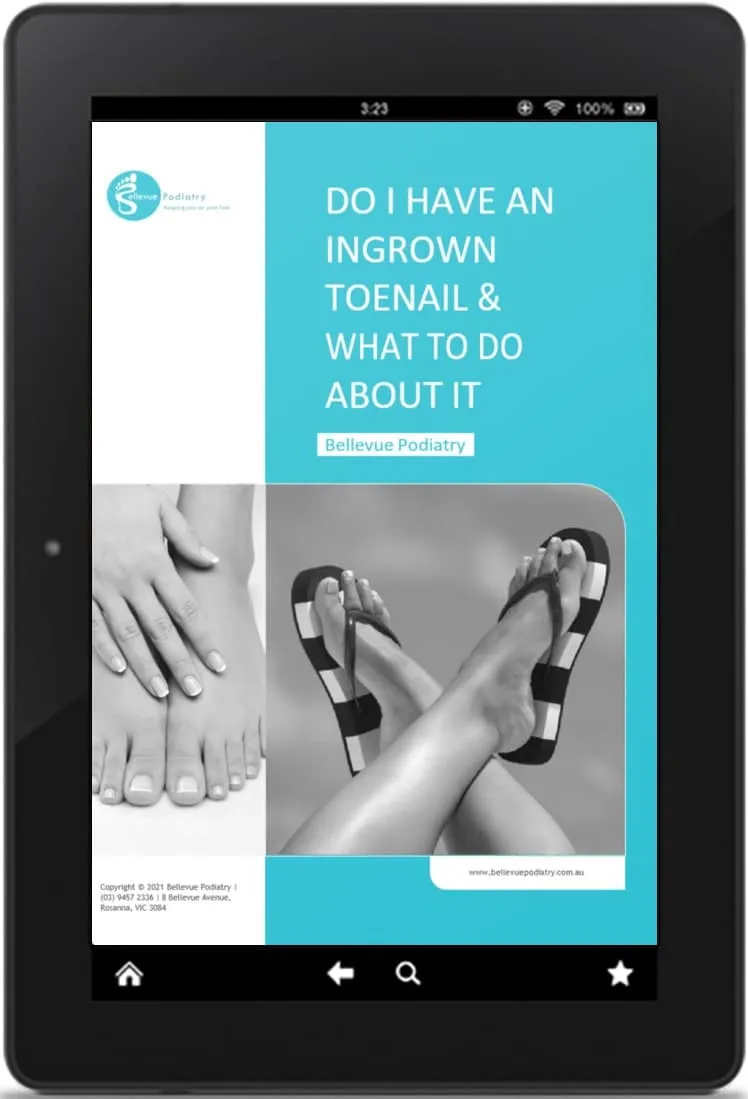Did you know that soaking your feet in warm, soapy water is one of the simplest yet most effective ways to treat an ingrown toenail?
If you’ve ever experienced the throbbing pain and redness accompanying this frustrating problem, you’ll be relieved to find out there are several straightforward steps you can take at home (word of warning though, these home remedies are only shown to have a degree of success with very early stage ingrown toenails).
These methods, from using dental floss to lift the nail to applying Vaseline and bandaging, can ease discomfort. However, more discussion is needed about when these remedies may not be appropriate, and the professional guidance of a podiatrist is actually required. So if you currently have an ingrown toenail, or suspect you may have one forming, please read this informative blog on what possible at home and podiatrty treatment options are available.
Identifying Ingrown Toenail Symptoms
Identifying symptoms early is important when dealing with an ingrown toenail to prevent complications. Knowing what to look for can help you take the right steps to treat it effectively.
Common ingrown toenail symptoms include pain, tenderness, redness, and swelling around the affected nail. You might also notice that the skin around the ingrown nail becomes hard or calloused.

Pain around the toenail can escalate, transforming into a sore toenail that makes walking or even touching the area uncomfortable. If left untreated, an ingrown toenail can lead to an infection. Infection symptoms include increased pain, pus drainage, and more pronounced redness and swelling. These symptoms intensify discomfort and can lead to more severe complications.
At Home Remedies You Can Try
Recognising the early symptoms is the time to quickly act with one or more of the following effective home remedies for treating an ingrown toenail:
- First, soak your foot in warm, soapy water multiple times daily. This can help reduce pain and swelling.
- After washing, you can place a small piece of cotton or dental floss under the ingrown edge of the nail. This gentle lift encourages the nail to grow correctly.
- Next, apply Vaseline jelly to the affected area and bandage your toe. This practice helps protect it from further irritation and infection.
- Wearing open-toed shoes or sandals also relieves pressure on the ingrown toenail and improves air circulation, promoting healing.
- Over-the-counter pain relievers like paracetamol or ibuprofen are effective for pain management. These medications can help alleviate discomfort and reduce inflammation.
Remember, for the best chances of success, you should perform these steps regularly for minor, early onset cases – and always seek professional advice if no positive progress is made after trying them for a couple days at most.
Effective Podiatry Treatments for Ingrown Toenails
To effectively treat ingrown toenails, consider visiting a podiatrist who can perform precise nail trimming to alleviate discomfort.
Options like the OnyFix Nail Brace Solution can guide proper nail growth without invasive procedures.
In some cases, ingrown toenail surgery may be necessary to provide lasting relief and prevent recurrence.
Podiatrist Nail Trimming
A podiatrist’s professional nail trimming is essential for effectively managing and alleviating the discomfort of ingrown toenails. A podiatrist uses precise cutting techniques to ensure correct and safe nail trimming, significantly reducing the risk of further ingrowth and complications.
This professional care doesn’t just relieve pain; it promotes proper healing and prevents future issues.
Regular visits to a podiatrist for nail trimming can be highly beneficial, especially if you’re prone to ingrown toenails. These routine check-ups ensure that your nails are kept at an optimal length and shape, preventing the recurring pain and potential infections associated with ingrown toenails.
Trusting a professional with your nail care allows you the freedom from constant discomfort and the assurance of expert treatment.

OnyFix Nail Brace Solution
The OnyFix Nail Brace Solution offers a non-invasive treatment option for correcting ingrown toenails by gently lifting and straightening the nail as it grows.
This method is an effective alternative to more invasive procedures because it uses a specialised brace to apply a gentle, corrective force to the nail. The brace gradually alleviates pain and pressure as the nail grows, promoting natural nail growth.
Here are some benefits of the OnyFix Nail Brace Solution:
- Non-invasive: no need for surgical intervention, minimizing discomfort and recovery time.
- It is cost-effective: a more affordable option compared to surgery or other intensive treatments.
- Efficient: Offers relief and correction over time, eliminating the need for frequent medical visits.
- Versatile: Suitable for various degrees of ingrown toenails, from mild to severe.
- It encourages natural growth, ensuring the nail grows correctly without changing its structure.

Ingrown Toeanil Surgery
Ingrown toenail surgery remains a highly effective podiatry treatment for more persistent cases. Surgical intervention might be necessary if your ingrown toenails don’t respond to conservative treatments. These procedures, typically performed under local anesthesia, involve removing a narrow nail strip to address the ingrown portion and prevent regrowth. This method, known as partial nail avulsion, is common and effective.
A chemical application sometimes inhibits nail regrowth in the affected area to prevent recurrence. Despite the term ‘surgery,’ these procedures are usually quick and performed in a clinical setting. Most patients can resume normal activities within a day or two, offering minimal disruption to their routine.
Choosing surgery can be a proactive step to alleviate pain and prevent complications. It’s a reliable solution for ensuring long-term relief from ingrown toenails.

When to Seek Professional Help
Seek medical assistance if your ingrown toenail causes severe pain, redness, or swelling. These symptoms may indicate an infection or a more severe condition that requires professional intervention.
While home remedies can offer relief for minor cases, don’t hesitate to consult an experienced ingrown toenail podiatrist if you notice any of the following signs:
- Pus or discharge can serve as precise indicators of infection
- If home treatments fail to provide relief, or if the symptoms worsen
- Underlying conditions like diabetes or circulatory issues, which can complicate healing
- It can be challenging to manage the condition independently
- The patient has recurring ingrown toenails that may require surgical intervention.
Infections can progress rapidly, leading to significant complications if not addressed promptly. If you have diabetes or circulation problems, an ingrown toenail can pose even more critical risks, making it crucial to seek medical advice without delay.
An experienced ingrown toenail podiatrist can offer appropriate treatments, from lifting the nail to minor surgical procedures, to alleviate your pain and prevent further issues.
By recognising when to seek assistance, you’re taking a proactive step to safeguard your foot health and overall well-being.
Ingrown Toenail Preventative Measures
There are several important habits you can adopt into your daily life that will significantly reduce your chances of developing an ingrown toenail:
-
Wear Proper Fitting Shoes
To prevent ingrown toenails, wear properly fitted shoes that provide sufficient toe room. Tight or ill-fitting shoes can press the toenails into the skin, leading to discomfort and potential growth. Opt for footwear that allows your toes to move freely, reducing unnecessary pressure.
-
Cut Toenails Correctly
Cutting your toenails correctly is essential. Always trim them straight across, avoiding rounding the corners. This technique helps prevent the nails from growing into the surrounding skin. Utilise a toenail clipper, not a fingernail clipper, for a more accurate cut suited to the toenails' thickness.
-
Maintain Good Foot Hygiene
Maintaining foot hygiene is another important preventative measure. Keep your feet clean and dry to ward off fungal infections that can exacerbate the risk of ingrown toenails. Regularly inspect your toenails for early signs of ingrowth, such as redness or tenderness, and address any issues promptly to prevent complications.
Incorporate these steps into your routine to maintain healthy toenails. These minor adjustments can significantly reduce your risk of developing ingrown toenails, allowing you to move freely and comfortably.
Summing It All Up...
Remember, ‘an ounce of prevention is worth a pound of cure.’ You can effectively manage and prevent ingrown toenails by soaking your feet, using cotton or dental floss, and maintaining proper foot hygiene.
However, if home remedies don’t bring relief or symptoms worsen, don’t hesitate to seek professional help from a podiatrist. Your feet are essential for mobility, so timely action guarantees long-term health and comfort. Stay proactive, and your feet will thank you.
If you think you may have an ingrown toenail and want the right professional advice on how to treat it, we currently have a limited offer running to help you out. A GAP FREE ingrown toenail assessment consult (only $59 for those without extras private insurance).
Please feel free to book yourself in online or call our friendly Reception on (03) 8104 9270 today.
Ingrown Toenail Infection
Understand how you get ingrown toenails your self care home options and what you can do to get rid of them once and for all. You don't need to put up with the pain of an ingrown toenail any longer.


Bellevue Podiatry Health Care Treatment
Bellevue Podiatry has been serving the people of Rosanna and its surrounding suburbs for over 10 years. We have the qualifications, experience and education to effectively treat any lower limb condition or injury that requires expert podiatry care.
Article References
- (2023). Ingrown Toenail. https://www.nhs.uk/conditions/ingrown-toenail/
- Mayo Clinic. (2023). Ingrown toenails. https://www.mayoclinic.org/diseases-conditions/ingrown-toenails/symptoms-causes/syc-20355904
- (2023). How to Treat and Prevent Ingrown Toenails. https://www.healthline.com/health/ingrown-toenail
- Ingrown Toenail Treatment,‘ Australian Podiatry Association. https://www.podiatry.org.au/ingrown-toenail-treatment
- ‘OnyFix Nail Brace Solution,’ OnyFix Australia. https://www.onyfix.com.au/nail-brace-solution
- Australian Podiatry Association. (2023). Ingrown Toenails. https://www.podiatry.org.au/foot-health/conditions/ingrown-toenails
- Healthdirect Australia. (n.d.). Ingrown Toenails. Retrieved from https://www.healthdirect.gov.au/ingrown-toenails
